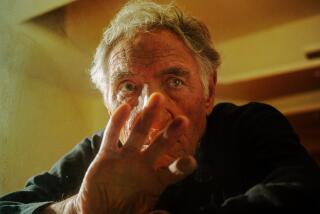Al Goldstein dies at 77; adult magazine publisher had fleeting success
If Hugh Hefner strove to put a suave, air-brushed image on sexual freedom in the 1960s, rival publisher Al Goldstein was the polar opposite. Unabashedly abrasive and foul-mouthed, the cigar-chomping, obese Goldstein called his explicit magazine Screw and seemingly reveled in giving the middle-finger sign not only to his enemies but also the world at large via an 11-foot sculpture of the gesture outside his Florida home.
“To be angry is to be alive,” Goldstein — who aggressively championed free speech rights — said in a New Times Broward-Palm Beach interview in 2001. “There’s so much to be angry about, because people are ripped off, the election went to the wrong person, the good guys usually lose, and society sucks.”
Goldstein, 77, died Thursday in a Brooklyn nursing home, said his attorney Charles DeStefano. Goldstein’s health had been declining for several years due to a stroke, diabetes and dementia, DeStefano said.
At the peak of his wealth, largely due to the three-decade success of Screw, which he co-founded in 1968, Goldstein had a personal fortune of millions of dollars, a chauffeur-driven Rolls-Royce and tons of electronic gadgets and other toys for his six homes including a mansion in Florida and an 8,000-square-foot townhouse in Manhattan.
But his fall from financial grace after the collapse of his pornography empire was epic. By the mid-2000s, Goldstein was homeless. He once got a job as a restaurant greeter, only to lose it when the management discovered he was sleeping on the premises.
Even in that period he reveled in irreverent humor. In 2005, when he worked at a New York deli, he told the Washington Post, “I’ve gone from broads to bagels.” But there was also the ever-present anger. “Anyone who wishes ill on me should feel vindicated,” he told the New York Times in 2004, “because my life has turned into a total horror.”
Al Goldstein was born Jan. 10, 1936, in Brooklyn. He worked as a taxi driver and photographer before launching Screw. “Screw grew from a combination of many factors, chief of which was my own dissatisfaction with the sex literature of 1968,” Goldstein wrote in a 1971 Screw anthology, “and my yearning for a publication that reflected my sexual appetites.”
Subtle, it was not. The first cover featured a woman in a two-piece bathing suit, holding a large salami. Inside “was a rag-tag assemblage of typo-filled articles and stock photographs of simulated carnal congress,” said Steven Heller in a New York Times review of Goldstein’s 2006 autobiography, “I, Goldstein.” (Heller, who at age 17 was Screw’s first art director, went on to a respected career with the newspaper.)
A regular feature in Screw, which never turned slick despite its success, were Goldstein’s reviews of porn movies and his ratings of massage parlors, and it was chock-full of advertisements for a panoply of sexual services. Reportedly, the biggest-selling issue was in 1973 when Goldstein published nude pictures of former first lady Jacqueline Kennedy Onassis surreptitiously taken as she was swimming at home in Greece.
Goldstein spun off other publications and in 1974 began hosting a notorious New York cable-TV show, “Midnight Blue,” that featured nude guests.
He fought and generally won indecency cases brought against him, often peppering the procedure with defiant rants. During a trial in which he was accused of harassing a former employee, he put out an issue of Screw that had on the cover a photo of two men in intimate embrace, with the faces of the judge and the case’s district attorney superimposed on the men. “He had no fear,” DeStefano said. (Goldstein lost the case but the conviction was later overturned.)
The one foe he was not prepared to battle was the Internet, which from early on featured free pornography and sex ads. “Unlike Larry Flynt, he didn’t have a business plan for that,” DeStefano said. Screw folded in 2003 and Goldstein’s flagrant spending during the lucrative years on top of four divorces and legal troubles proved disastrous. He filed for bankruptcy, and the homes and other possessions were sold off. He never bounced back financially.
DeStefano said that in the last few months Goldstein hardly spoke or showed emotion. “Then about a month ago on a visit, I showed him the middle finger and said, ‘Hey Al, this is for you,’” DeStefano said. “He smiled. That seemed to perk him up.”
Survivors include a son, Jordan, who is an attorney in New York. Goldstein married his fifth wife, Christine Ava Maharaj, in 2004 but the two had not been in contact for many years, DeStefano said.
More to Read
Start your day right
Sign up for Essential California for the L.A. Times biggest news, features and recommendations in your inbox six days a week.
You may occasionally receive promotional content from the Los Angeles Times.







